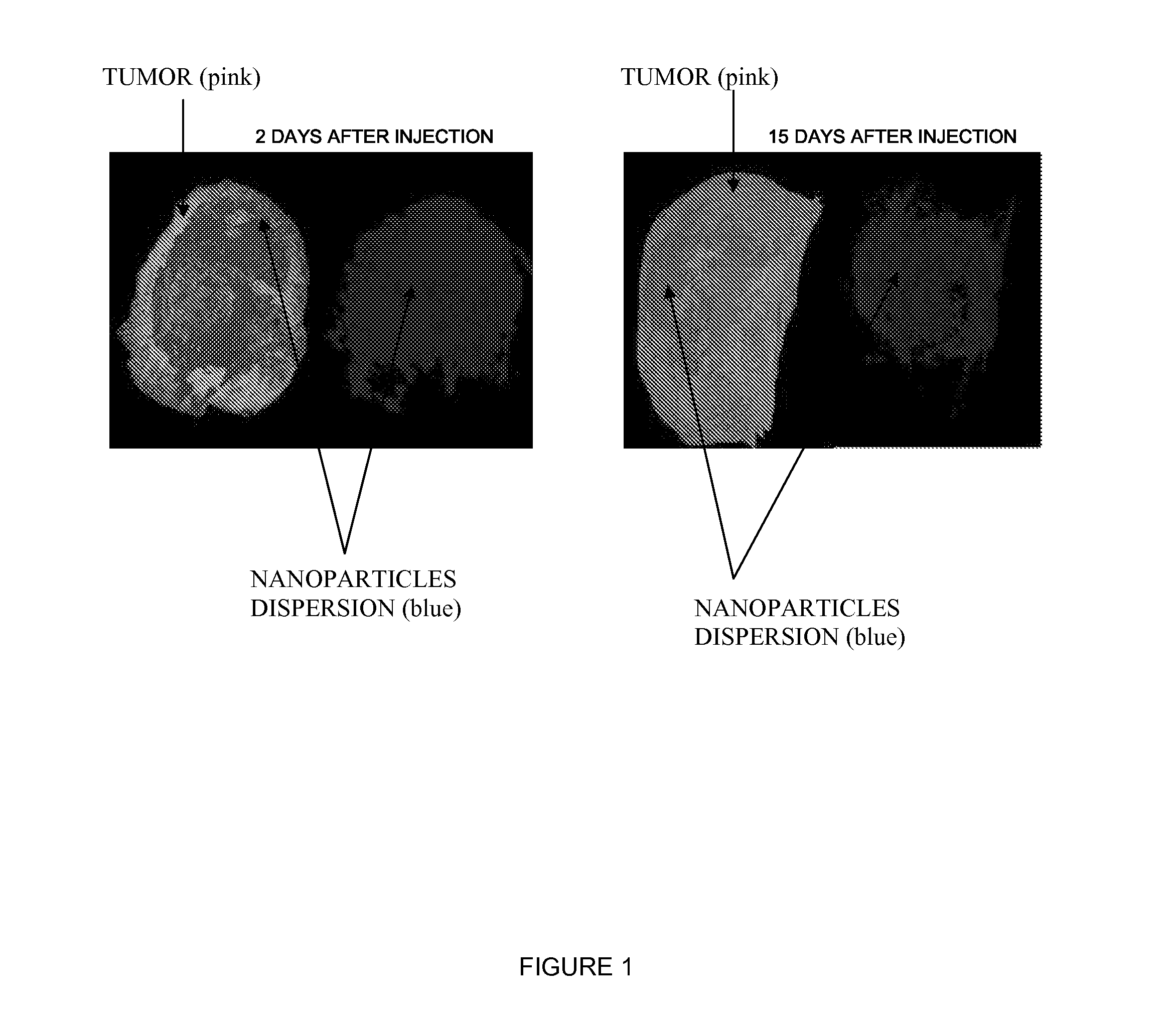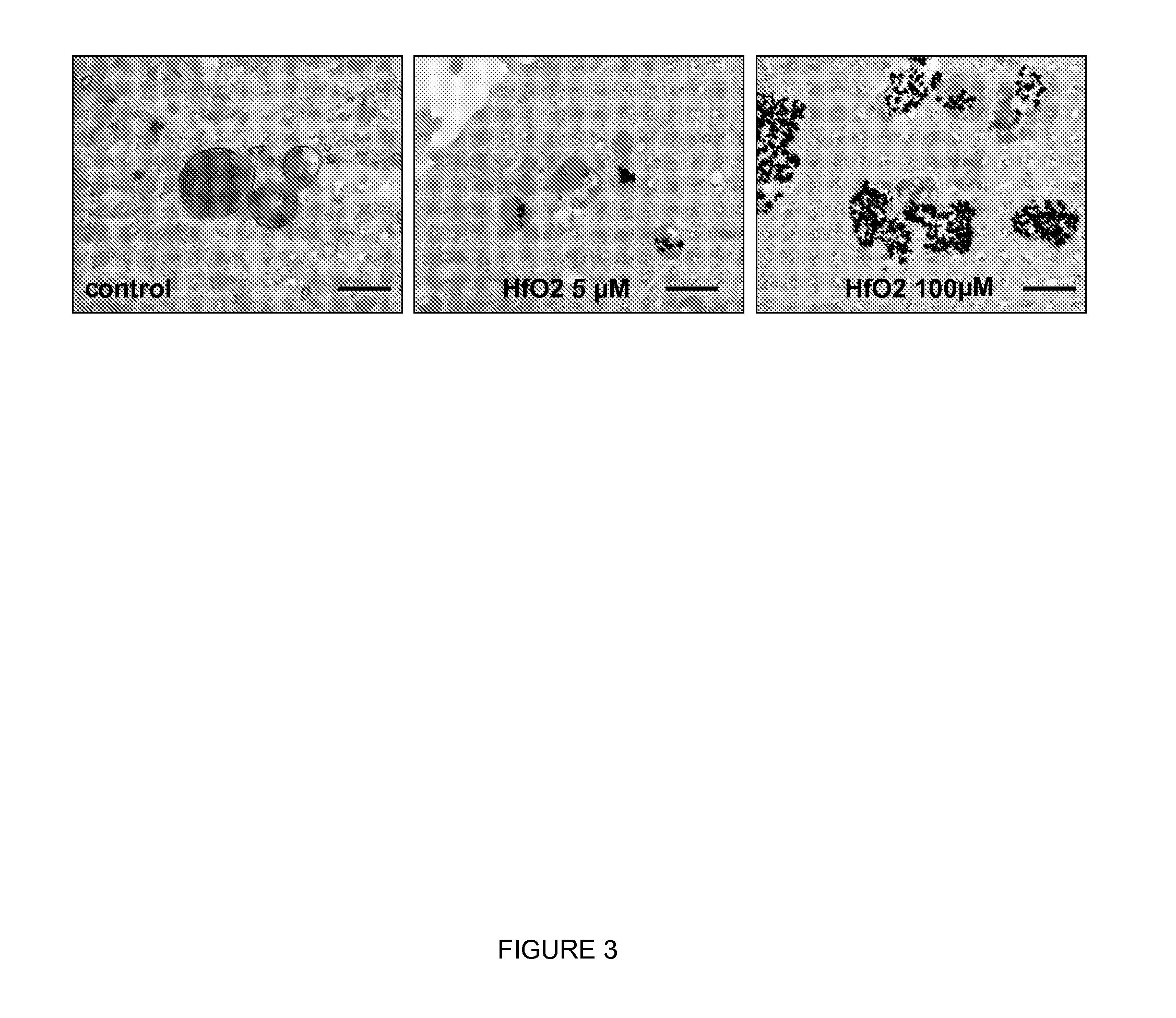Inorganic nanoparticles of high density to destroy cells in-vivo
a high-density, inorganic technology, applied in the field of excitable particles, can solve the problem that doping agents may be associated with an increased toxicity, and achieve the effect of reducing the risk of cancer
- Summary
- Abstract
- Description
- Claims
- Application Information
AI Technical Summary
Benefits of technology
Problems solved by technology
Method used
Image
Examples
example 1
[0290]Biocompatible suspension of hafnium oxide (HfO2) nanoparticles or nanoparticle aggregates with a density above 7 g / cm3, using sodium trimetaphosphate as cating agent.
[0291]A Tetramethylammonium hydroxide (TMAOH) solution is added to 40 g of HfCl4 solution. Addition of TMAOH solution is performed until the pH of the final suspension reaches a pH comprised between 7 and 13. A white precipitate is obtained.
[0292]The precipitate is further transferred in an autoclave and heated at a temperature comprised between 120° C. and 300° C. to perform crystallization. After cooling, the suspension is washed with de-ionized water.
[0293]A peptization step, is performed in order to get a stable suspension of nanoparticles or nanoparticle aggregates.
[0294]Suspension of Sodium trimetaphosphate is then added to the peptized solution (the amount of sodium trimetaphosphate added being below lethal dose (LD) 50 / 5) and the pH of the suspension is adjusted to a pH comprised between 6.5 and 7.5.
[0295]...
example 2
[0299]Biocompatible suspension of hafnium oxide (HfO2) nanoparticles or nanoparticle aggregates with a density below 7 g / cm3, using sodium trimetaphosphate as coating agent.
[0300]A Tetramethylammonium hydroxide (TMAOH) solution is added to 40 g of HfCl4 solution. Addition of TMAOH solution is performed until the pH of the final suspension reaches a pH comprised between 1 and 5. A white precipitate is obtained.
[0301]The precipitate is further transferred in an autoclave and heated at a temperature comprised between 120° C. and 300° C. to perform crystallization. After cooling, the suspension is washed with de-ionized water.
[0302]A peptization step, is performed in order to get a stable suspension of nanoparticles or nanoparticle aggregates.
[0303]Suspension of Sodium trimetaphosphate is then added to the peptized solution (the amount of sodium trimetaphosphate added being below LD50 / 5) and the pH of the suspension is adjusted to a pH comprised between 6.5 and 7.5.
[0304]For in vitro ex...
example 3
[0308]Biocompatible suspension of hafnium oxide (HfO2) nanoparticles or nanoparticle aggregates with a density above 7 g / cm3, using sodium hexametaphosphate as coating agent.
[0309]A Tetramethylammonium hydroxide (TMAOH) solution is added to 40 g of HfCl4 solution. Addition of TMAOH solution is performed until the pH of the final suspension reaches a pH comprised between 7 and 13. A white precipitate is obtained.
[0310]The precipitate is further transferred in an autoclave and heated at a temperature comprised between 120° C. and 300° C. to perform crystallization. After cooling, the suspension is washed with de-ionized water.
[0311]A peptization step, is performed in order to get a stable suspension of nanoparticles or nanoparticle aggregates.
[0312]Suspension of Sodium hexametaphosphate is then added to the peptized solution (the amount of sodium hexametaphosphate added being below LD50 / 5) and the pH of the suspension is adjusted to a pH comprised between 6.5 and 7.5.
[0313]For in vitr...
PUM
 Login to View More
Login to View More Abstract
Description
Claims
Application Information
 Login to View More
Login to View More - R&D
- Intellectual Property
- Life Sciences
- Materials
- Tech Scout
- Unparalleled Data Quality
- Higher Quality Content
- 60% Fewer Hallucinations
Browse by: Latest US Patents, China's latest patents, Technical Efficacy Thesaurus, Application Domain, Technology Topic, Popular Technical Reports.
© 2025 PatSnap. All rights reserved.Legal|Privacy policy|Modern Slavery Act Transparency Statement|Sitemap|About US| Contact US: help@patsnap.com



